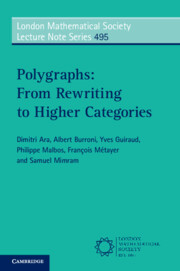Book contents
- Frontmatter
- Contents
- Preface
- Part I Fundamentals Of Rewriting
- Part II Coherent Presentations
- 7 Coherence by Convergence
- 8 Categories of Finite Derivation Type
- 9 Homological Syzygies and Confluence
- Part III Diagram Rewriting
- Part IV Polygraphs
- Part V Homotopy Theory of Polygraphs
- Appendices
- References
- Index of Symbols
- Subject Index
9 - Homological Syzygies and Confluence
from Part II - Coherent Presentations
Published online by Cambridge University Press: 18 March 2025
- Frontmatter
- Contents
- Preface
- Part I Fundamentals Of Rewriting
- Part II Coherent Presentations
- 7 Coherence by Convergence
- 8 Categories of Finite Derivation Type
- 9 Homological Syzygies and Confluence
- Part III Diagram Rewriting
- Part IV Polygraphs
- Part V Homotopy Theory of Polygraphs
- Appendices
- References
- Index of Symbols
- Subject Index
Summary
Squier showed in his 1987 article that a convergent presentation of a monoid yields a partial resolution generated by the set of generators in dimension 1, by the set of rules in dimension 2, and by the critical branchings in dimension 3. If moreover the presentation is finite, the Squier resolution is finitely generated up to dimension 3. In this case, the monoid is said to be of homological type left-FP3. This property readily implies that the third integral homology group of the monoid is finitely generated. Therefore, a monoid whose third homology group is not finitely generated does not admit a finite convergent presentation. By explicitly exhibiting an example of this type, Squier first provided a negative answer to the question of universality of convergent rewriting.
Keywords
- Type
- Chapter
- Information
- Polygraphs: From Rewriting to Higher Categories , pp. 192 - 206Publisher: Cambridge University PressPrint publication year: 2025

